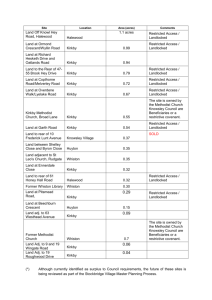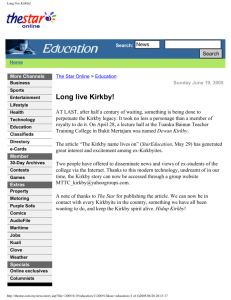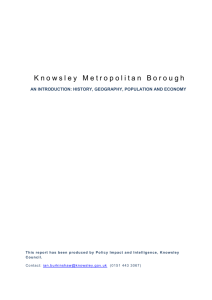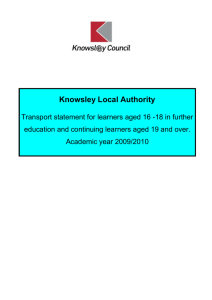summary is also available here - George Howarth, Labour MP for
advertisement
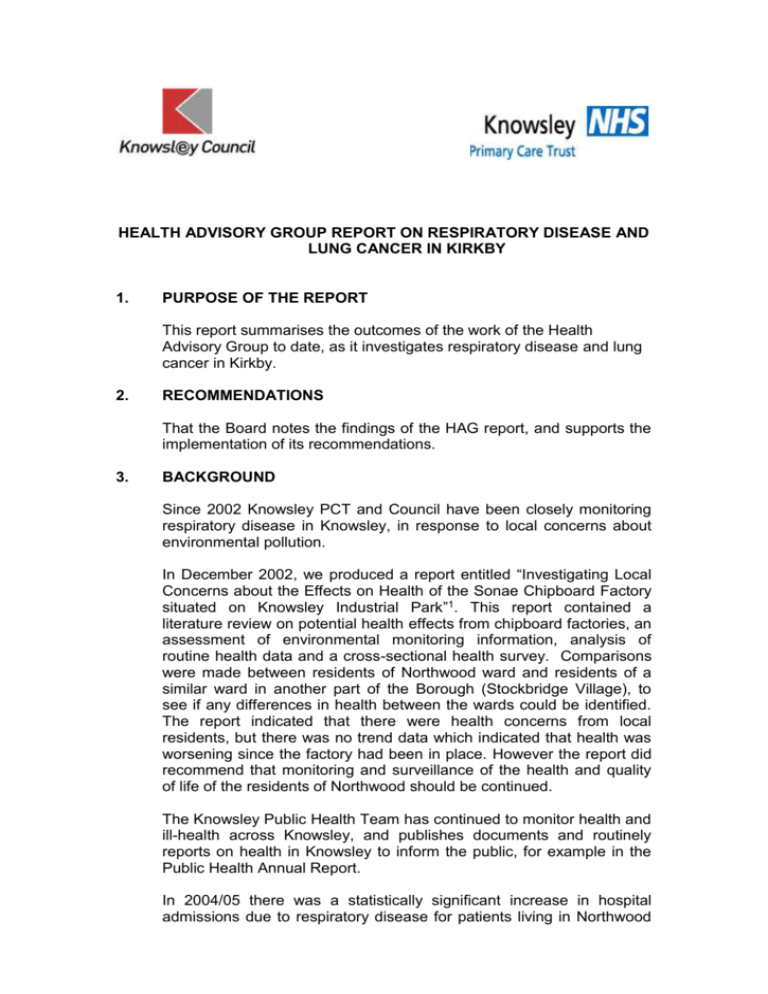
HEALTH ADVISORY GROUP REPORT ON RESPIRATORY DISEASE AND LUNG CANCER IN KIRKBY 1. PURPOSE OF THE REPORT This report summarises the outcomes of the work of the Health Advisory Group to date, as it investigates respiratory disease and lung cancer in Kirkby. 2. RECOMMENDATIONS That the Board notes the findings of the HAG report, and supports the implementation of its recommendations. 3. BACKGROUND Since 2002 Knowsley PCT and Council have been closely monitoring respiratory disease in Knowsley, in response to local concerns about environmental pollution. In December 2002, we produced a report entitled “Investigating Local Concerns about the Effects on Health of the Sonae Chipboard Factory situated on Knowsley Industrial Park”1. This report contained a literature review on potential health effects from chipboard factories, an assessment of environmental monitoring information, analysis of routine health data and a cross-sectional health survey. Comparisons were made between residents of Northwood ward and residents of a similar ward in another part of the Borough (Stockbridge Village), to see if any differences in health between the wards could be identified. The report indicated that there were health concerns from local residents, but there was no trend data which indicated that health was worsening since the factory had been in place. However the report did recommend that monitoring and surveillance of the health and quality of life of the residents of Northwood should be continued. The Knowsley Public Health Team has continued to monitor health and ill-health across Knowsley, and publishes documents and routinely reports on health in Knowsley to inform the public, for example in the Public Health Annual Report. In 2004/05 there was a statistically significant increase in hospital admissions due to respiratory disease for patients living in Northwood Ward (old boundaries). As a result the Public Health Team asked the Cheshire and Merseyside Health Protection Unit to look into this and advise whether it was likely that factors other than smoking were responsible for this. The report from the Health Protection Unit2 was completed in 2006, and showed that the highest prevalence of chronic respiratory disease in Knowsley was in Northwood. However a high prevalence of chronic respiratory disease was also seen in other wards in Knowsley with similar socio-economic status and smoking prevalence. The report had four recommendations:1. The Local Authority should undertake monitoring of air quality in Northwood. 2. More accurate assessment of smoking prevalence in Northwood wards should be determined. 3. Monitoring of the respiratory health of residents in the north of Knowsley should be continued. 4. A Health Advisory Group should be formed to undertake more detailed study into this issue. As a result of the recommendations from the report, the PCT worked with the Local Authority to secure funding to refurbish and redevelop the existing air quality monitoring station based at Huyton in order that it could be updated and moved to various sites across the Borough, including Northwood to measure air quality. In addition the public health team has continued to monitor the respiratory health of residents across Knowsley. Knowsley PCT also commissioned research into smoking prevalence both in Kirkby and across Knowsley, and this report was published in 20073. The final recommendation was to form a Health Advisory Group (HAG) to bring together experts to look into this issue in more detail. The first meeting of the HAG was held in September 2006 and included representation from the PCT, the Local Authority and the Health Protection Agency. The full membership of the group is shown in Appendix A. The purpose of the group was twofold: To gain a clearer understanding of any additional factors (other than smoking) which may be contributing to the high rates of lung cancer and respiratory disease in Kirkby. To communicate the findings to the public, through the Cancer Monitoring Forum. In order to undertake this work, the Health Advisory Group found it was necessary to look at the trends for respiratory disease and lung cancer in all the wards in Knowsley, so that comparisons could be made. Work was also undertaken to look into the history of Kirkby residents, in terms of housing and facilities, and also employment. The data on 2 smoking prevalence was examined, as was the available data on air quality and land pollution. The report details the work carried out by the HAG so far, and includes conclusions and recommendations from each of the areas of investigation. This report to the Board is a summary. 4. SUMMARY OF MAIN FINDINGS Respiratory Disease The increase in hospital admissions due to respiratory disease is not only being seen in Knowsley; it is happening across the North West Region Hospital admission rates for respiratory disease are highest in North Huyton and South Kirkby. Hospital admission rates for respiratory disease are increasing significantly in North Huyton and North Kirkby. Chronic Obstructive Pulmonary Disease Knowsley is a national ‘hotspot’ for COPD Hospital admission rates for COPD in Knowsley are much higher than the national and regional rates. They have increased in the past four years and are now higher than they were in1997. Hospital admission rates for COPD are highest in North Kirkby, South Kirkby and North Huyton. However, rates have reduced in North Kirkby and South Kirkby but increased in North Huyton. This would indicate that the factors leading to the high rates in Kirkby are less likely to be current environmental factors coming from the industrial estate, and more likely to be due to people’s past working or smoking history. Mortality trends for COPD in Knowsley have not reflected these increasing hospital admission rates. This may indicate improving hospital care for people with COPD, and/or that more people are being admitted to hospital with COPD, when in the past they would have been treated at home. The new intermediate care service for people with COPD may reduce hospital admission rates Asthma Hospital admission rates for asthma have increased by 37% in Knowsley, since 1999-2001. The rates are highest in North Kirkby, South Kirkby and North Huyton. The rates have increased most 3 markedly in Northwood, Whitefield and Kirkby Central wards. They have also increased in North Huyton. There has been a steady increase in hospital admissions for asthma in children in the South Kirkby wards since 2000-2002, but not in North Kirkby. The highest hospital admission rates for asthma in children in the Borough are in Prescot, Whiston, Cronton and Knowsley Village, and these have also been increasing, at a similar rate as in South Kirkby. The factors causing this need further investigation. Pneumonia Hospital admission rates for pneumonia in Knowsley reflect the Regional pattern of an increase of 71% since 1997-99. The highest rates are in South Kirkby and South Huyton. The rates showed a decrease in most Kirkby wards in 2004-06, except Kirkby Central, where they continued to increase. Mortality rates for pneumonia have decreased down to regional levels, which must reflect improved management of the disease. There is no need to continue to monitor levels of pneumonia, as part of the work of the Health Advisory Group. Lung Cancer Mortality rates for lung cancer in Knowsley are very high. The highest rates are in Page Moss, Stockbridge Village and Kirkby Central. There was an unexplained sharp increase in lung cancer deaths in Kirkby between 2002-04 and 2003-05. Rates in Kirkby are now no longer significantly higher than the Borough average. The Liverpool Lung Project should in the future provide a wealth of data on the factors causing lung cancer in Knowsley. Smoking Prevalence The areas with high levels of respiratory disease and lung cancer in Knowsley are the areas with high levels of smoking. These also reflect high levels of people who are economically inactive. Levels of smoking are still much higher than the national average, particularly in women, which is a concern in relation to future patterns of respiratory disease. Environmental Health Any industries which could potentially cause pollution in Knowsley are closely regulated, either by the Environment Agency or by the 4 Council. Extra environmental monitoring is now being developed in Kirkby. History of Kirkby 5. 4. Many Kirkby residents who are now suffering from respiratory disease have lived through the period of unsuitable housing in the 1970s and economic decline in the 1980s in the area. A combination of poor living conditions and unemployment will have contributed to more people having an unhealthy lifestyle. There is a similar history in North Huyton, where levels of respiratory disease are also high. THE REPORT’S RECOMMENDATIONS That the findings from this report are summarised, and shared with key stakeholders and local people. That the impact of the new intermediate respiratory care service on hospital admissions for COPD is closely monitored. That improved management of asthma in both adults and children, and the education of parents and patients about asthma, is given higher priority within Knowsley. That the high rates of hospital admission for asthma in children in Prescot, Whiston, Cronton and Knowsley Village are explored further. That continued high priority is given to supporting people to give up smoking, especially in Kirkby and North Huyton. That air monitoring in Kirkby should continue for at least one full year. That the Health Advisory Group should continue to monitor respiratory disease in Kirkby. RESOURCE IMPLICATIONS 4.1 Financial None 4.2 Human None 4.3 Information Technology None 5 4.4 Physical Assets None 5. RISK ASSESSMENT This report has highlighted the problems that a high proportion of Knowsley residents experience with respiratory disease and lung cancer. This limits people’s quality of life, and leads to premature deaths. It is important that the recommendations from the report are actioned, if we are to make headway in reducing respiratory disease in the future. 6. LEGAL IMPLICATIONS There are currently no legal implications. 7. IMPACT ON POPULATION GROUPS This report has indicated that respiratory disease is more of a problem in the more deprived parts of the Borough. 8. COMMUNICATIONS ISSUES The findings of the Health Advisory Group report needs to be shared with the Kirkby Cancer Monitoring Forum, the Kirkby Health Forum, local elected members, and front-line staff. 9. CONCLUSION The Health Advisory Group report has looked in detail at trends for hospital admissions and mortality for respiratory disease in Kirkby, and compared these with other parts of the Borough. The headline issues which come out of this report are as follows: The increases in hospital admissions for respiratory disease which are seen in Kirkby, are mirrored also in North Huyton. The very high rates of lung cancer which were seen in Kirkby between 2000 and 2004 have now returned to rates similar to the Knowsley average. The factors leading to this will have occurred ten to fifteen years ago. Kirkby and North Huyton have similar levels of deprivation, similar levels of smoking, similar history, and similar patterns of respiratory disease. There is, however, no industrial estate in North Huyton. This would indicate that the current respiratory disease of residents in Kirkby has been affected by people’s past history (occupation and smoking), rather than by recent air pollution. It is important that close monitoring of the health of the residents of Kirkby continues. The Health Advisory Group will report back the 6 contents of this report to local people, and to local stakeholders, and the work of the group will continue. SIGNATORIES Dr Diana Forrest Director of Public Health February 2008 Background Documents: Knowsley Health Advisory Group Report, Respiratory Disease and Lung Cancer in Kirkby, February, 2008 Appendix A Membership of the Health Advisory Group 7 APPENDIX A MEMBERS OF THE HEALTH ADVISORY GROUP Diana Forrest - Director of Public Health (Chair) Matt Ashton - Public Health Development Specialist Mary Farrell - Public Health Development Manager Paul Langton - Public Health Intelligence Manager Ben O’Brien - Assistant Director of Marketing & Communications Anne Crabtree - Arts in Health Officer John Baxter - Environmental Protection Manager, Public Health and Consumer Protection, KMBC Richard Jarvis - Consultant in Communicable Disease Control, Health Protection Agency Alex Keenan - Epidemiology and Surveillance Analyst, Health Protection Unit Vinay Bothra - Specialist Registrar in Public Health, Health Protection Unit Anjila Shah - Specialist Registrar in Public Health, Health Protection Unit Adrian Cassidy - Roy Castle Lung Cancer Research Programme, LJMU Gordon Whitaker - Environment Agency Keith Osborn - Chief Scientist – United Utilities 8

